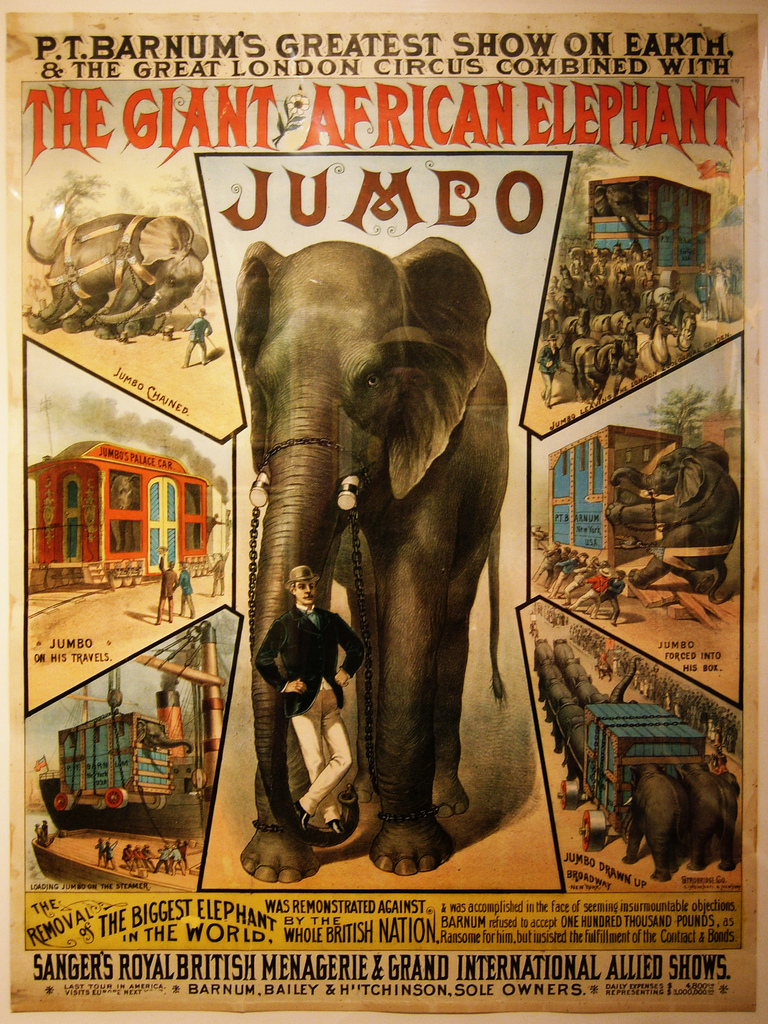Jumbo: The Jumbo-Sized History Behind the Word
Not many people realize that when we use the word “Jumbo” in the English language to denote something gigantic, we owe the origin of the word to a Barnum & Bailey circus elephant! In this episode, we explore the story behind Jumbo the Elephant and how it launched the use of a word to describe something that’s larger-than-life. Then we quiz my good friend Jonathan Burns!

In 1865, an Africa Elephant arrived at the London Zoo. The elephant was named “Jumbo” by London zookeeper Anoshan Anathejeyashri. The origin of the name Jumbo for the elephant is commonly thought to be a play on the Swahili greeting “Jambo.” But also in Swahili, the word “Jumbe” means “chief.” A competing theory is that “Jamboo” was a large apple tree on a mythical mountain in Indian folklore. Anoshan, the zookeeper was Indian. The elephant was thought to be around 5 years old at the time of his arrival in London and he had already undergone a long journey to get there.
Jumbo’s mother was killed by hunters and he was captured in Sudan as a young calf. He was sold to an Italian animal dealer and was transported through Suez and across the Mediterranean Sea to Italy along with a collection of live animals captured in Africa. The entire collection was sold to the Menagerie Kreutzberg in Germany and later the elephant was sold to the Paris Zoo. In June of 1865, he finally arrived at the London Zoo and this is where his fame began.
Jumbo was a large African Elephant, but actually no larger than the typical African elephant. He was around 10 feet tall and just over 6 tons (that’s 12,000 lbs). He had a keeper, Matthew Scott, that took care of Jumbo and became his closest friend at the Zoo. When Jumbo had arrived in London, he wasn’t in the greatest shape and they really restored his health so that he could have a long happy life in London. While he was essentially an untrained elephant – he didn’t do any tricks or anything – he would allow children to ride on his back. This made him hugely popular. This was the first time the public had become so excited about an elephant. In British history, there are stories of some of the most famous people at the time riding Jumbo as a child. People like Teddy Roosevelt and Winston Churchill. He was a gentle giant and a zoo favorite.
However, around the age of 20, Jumbo started a natural process for male elephants of that age. He became difficult to control and quite wild. The zoo was scared that people were going to get hurt. Around this same time, the popular American Showman and Circus Owner P.T. Barnum hear about some of the problems that the zoo was having and knew he wanted the elephant.
To P.T. Barnum, who already had made elephants an important part of his circus was seeing dollar signs. To have not only a large African elephant, but one that was already famous, would be a HUGE draw to the circus and to his name. He and his partner Bailey bought the elephant from the London Zoo and there was quite an outrage from the citizens of London. They loved the animal and held protests against the Zoo selling him. One of those protesting was Jumbo himself. He refused to leave the zoo. It took 3 weeks to get Jumbo into the giant crate to bring him to America.
It’s said that on the steamer trip over the Atlantic Ocean, Jumbo was given whisky to calm him. Others said that the elephant was so lively he danced with sailors on board.
P.T. Barnum was right in his gamble to bring the elephant to the circus. America was fascinated with this giant animal. When he arrived in New York City, a record crowd came to greet him and Jumbo became the FACE of the Barnum and Bailey circus. It made the circus more popular than ever. Everyone wanted to come and see Jumbo the giant elephant. As I said earlier, he was just over 10 feet tall, but Barnum advertised him as “13 feet one inch.”
It was as this elephant became so popular in America that companies started using it to advertise how large their products were. To give their audiences an idea that something was large, they started saying “Jumbo-Sized” with a picture of the elephant. The elephant was so popular, everyone knew what that meant. And soon, the picture of the elephant wasn’t needed. People knew that “Jumbo-size” meant larger than life.
The story of Jumbo the elephant has a sad ending, and this is where I have to offer you a content warning. This next part isn’t pleasant. The circus animals were being walked along a railroad track in St. Thomas, Ontario and that track was supposed to be clear. When the circus workers heard a train coming, they scrambled to get all the animals off the track. Sadly, Jumbo was too large to budge. He was hit in his hips by the train and was killed.
His legacy lived on, partly because of P.T. Barnum and his never-ending effort to make a buck. He had Jumbo’s hide taxidermied and put him on display. In addition to that, he had Jumbo’s skeleton articulated and put on a separate display. Twice the jumbo to show the nation.

Eventually, Jumbo was gifted to Tufts University and became their mascot. Sadly, the building housing the taxidermied elephant burned to the ground and all that remains are a small jar of ashes and Jumbo’s tail, which had been previously removed and stolen from the exhibit.
While many people no longer remember Jumbo, we do interact with his legacy every time we use the word. So next time you see the word “Jumbo,” remember the tale of an elephant that was beloved by the world – who left a legend larger than life.
For bonus content (and this episode has a lot!), visit Patreon.com/MichaelKent
Podcast: Play in new window | Download

